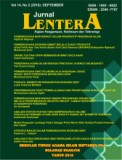PENDIDIKAN AGAMA ISLAM SEBAGAI PENCEGAH JUVENILE DELINQUENCY
Abstract
The challenges of Islamic education in the era of globalization are getting stronger now. It’s visible clearly changes happening so fast. The rapid of globalization is not only affect for adults, but also children, adolescents. A problem that often arises in the community revolves around the problems of Juvenile (teenagers), education and social community. Because adolescence is known as self-identity searching, so teens that can fulfill their role will have a positive impact, such as children understand their responsibilities better, and if they cannot, then there will emerge the exact opposite behavior that occurs an aberration or delinquency (juvenile delinquency). The existence of juvenile delinquency at this time also affect increasing in crime or criminal behavior in community. Juvenile delinquency can destroy moral values, the noble values of religion, and the various aspects of the subject matter contained therein. Understanding, deepening, and adherence to the teachings of religion, especially Islamic education is required by the juvenile. Because Islamic education is a systematic effort by educators and adults to students both physical and spiritual by Islamic law to led the formation of personality according to the standard of Islam. Because in fact the children or adolescents who commit delinquency or crime mostly less understand the norms of Islam, perhaps they are negligent in fulfill the commandments of religion.
References
Achmadi. Ideologi Pendidikan Islam Paradigma Humanisme Teosentris. Yogyakarta: Pustaka Pelajar, 2005.
Azra, Azyumardi. Pendidikan Islam: Tradisi dan Modernisasi Menuju Milenium Baru. Jakarta: Logos Wacana Ilmu, 2002.
Daradjat, Zakiah. Kesehatan Mental, Cet. 10. Jakarta: Gunung Agung, 1993.
_________. Peranan Agama dalam Kesehatan Mental. Jakarta: CV. Haji Masagung, 1995.
____________. Perawatan Jiwa Untuk Anak-Anak, Cet. 2. Jakarta: Bulan Bintang, 1973.
Echols, John M. dan Hassan Shadily. Kamus Inggris Indonesia (An English-Indonesian Dictionary), Cet. 23. Jakarta: PT. Gramedia, 1996.
Kartono, Kartini. Patologi 2 Kenakalan Remaja, Cet. 5. Jakarta: PT. Raja Grafindo, 2003.
_________. Patologis Sosial 3 Gangguan-Gangguan Kejiwaan. Jakarta: CV. Rajawali, 1986.
Kelana, Muslim. Muhammad Saw is A Great Entrepreneur. Bandung: Dinar Publishing, 2008.
Muhaimin. Nuansa Baru Pendidikan Islam (Jakarta: Raja Grafindo Persada, 2006.
Nahlawi (an), Abdurrahman. Prinsip-Prinsip dan Metoda Pendidikan Islam, terj. Herry Noer Ali. Bandung: CV. Diponegoro, 1996.
Nasution, S. Sosiologi Pendidikan. Jakarta: Bumi Aksara, 2009.
Ramayulis. Ilmu Pendidikan Islam. Jakarta: Kalam Mulia, 2004.
Salim, Peter. Salim Ninth Collegiate English Indonesian Dictionary. t.t.: Modern English Press, t.th.
Sarwono, Sarlito Wirawan. Psikologi Remaja, Cet. 3. Jakarta: PT. Raja Grafindo Persada, 1994.
Shadily, Hassan. Sosiologi Untuk Masyarakat Indonesia. Surabaya: PT. Pembangunan, 1980.
Soekanto, Soerjono. Sosiologi Suatu Pengantar. Jakarta: PT. Raja Grafindo Persada, 2003.
Yunus, Mahmud. Metode Khusus Pendidikan Agama. Jakarta: PT. Hidakarya Agung, 1983.
Wadong, Maulana Hasan. Pengantar Advokasi dan Hunkum Perlindungan Anak. Jakarta: PT. Grafindo, 2000.
Copyright (c) 2016 JURNAL LENTERA : Kajian Keagamaan, Keilmuan dan Teknologi

This work is licensed under a Creative Commons Attribution-NonCommercial-NoDerivatives 4.0 International License.

